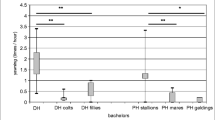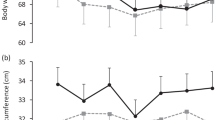Abstract
We studied sex differences in the nature of aggression and dominance behaviour in two newly formed groups of 1-year-old Icelandic horses. One herd contained nine geldings, the other nine mares. The groups were matched with regard to dominance-determining traits such as age, weaning age, composition of native herd, social experience, genetic origin, body condition and maternal dominance status. High-ranking individuals of both sexes were more aggressive, high-ranking males were older, and high-ranking females had a better body condition. Frequencies of aggressions were similar in both groups. The mares reacted significantly more by showing submission upon an aggression rather than by not responding or by escalating the aggression. For the geldings, this difference was not observed due to a lower tendency to submit. A linear dominance hierarchy was found in both groups. David’s scores provided additional information regarding cardinal rank distances and were used to calculate steepness of hierarchies. The female hierarchy was somewhat steeper compared to the male hierarchy, suggesting somewhat lower despotism among males. This was mainly a consequence of the lower unidirectionality in male submission. Male contests occurred predominantly between dyads at top and mid positions, suggesting a low degree of acceptance of the hierarchy.



Similar content being viewed by others
References
Altmann SA (1974) Observational study of behaviour: sampling methods. Behaviour 49:227–267
Anisko JJ, Christensen T, Buehler MG (1973) Effects of androgen on fighting behavior in male and female Mongolian gerbils (Meriones unguiculatus). Horm Behav 4:199–208
Appleby MC (1983) The probability of linearity in hierarchies. Anim Behav 31:600–608
Barroso FG, Alados CL, Boza J (2000) Social hierarchy in the domestic goat: effect on food habits and production. Appl Anim Behav Sci 69:35–53
Bateman AJ (1948) Intra-sexual selection in Drosophila. Heredity 2:349–368
Berger J (1986) Wild horses of the Great Basin. The University of Chicago Press, Chicago, pp 326
Berger J (1977) Organization systems and dominance in feral horses in the Grand Canyon. Behav Ecol Sociobiol 2:131–146
Clutton Brock TH, Greenwood PJ, Powell RP (1976) Ranks and relationships in Highland ponies and Highland cows. Z Tierpsychol 41:202–216
Dabbs JM Jr Carr S, Frady R, Riad J (1995) Testosterone, crime, and misbehavior among 692 male prison inmates. Pers Individ Differ 18:627–633
David HA (1987) Ranking from unbalanced paired-comparison data. Biometrika 74:432–436
De Vries H (1995) An improved test of linearity in dominance hierarchies containing unknown or tied relationships. Anim Behav 50:1375–1389
De Vries H (1998) Finding a dominance order most consistent with a linear hierarchy: a new procedure and review. Anim Behav 55:827–843
De Vries H, Netto WJ, Hanegraaf PLH (1993) MATMAN: a program for the analysis of sociometric matrices and behavioral transmission matrices. Behaviour 125:157–175
De Vries H, Stevens J, Vervaecke H (2006) Measuring and testing steepness of dominance hierarchies. Anim Behav 71:585–592
Drews C (1993) The concept and definition of dominance in animal behaviour. Behaviour 125:283–311
Ellis L (1995) Dominance and reproductive success among nonhuman animals: a cross-species comparison. Ethol Sociobiol 16:257–333
Feh C (1990) Long term paternity data in relation to different aspects of rank for Camargue stallions. Anim Behav 40:995–996
Floody OR (1983) Hormones and aggression in female mammals. In: Svare BB (ed) Hormones and aggressive behavior. Plenum Press, New York, pp 39–89
Galimberti F, Fabiani A, Boitani L (2003) Socio-spatial levels in linearity analysis of dominance hierarchies: a case study on elephant seals. J Ethol 21:131–136
Gammell MP, De Vries H, Jennings DJ, Carlin CM, Hayden TJ (2003) David’s score: a more appropriate dominance ranking method than Clutton-Brock et al.’s index. Anim Behav 66:601–605
Harcourt AH (1987) Dominance and fertility among female primates. J Zool Lond 213:471–487
Hemelrijk L, Gygax L (2004) Dominance styles, differences between the sexes and species. Interact Stud 5(1):131–146
Houpt KA, Wolski TR (1980) Stability of equine hierarchies and the prevention of dominance related aggression. Equine Vet J 12(1):15–18
Houpt KA, Keiper RP (1982) The position of the stallion in equine social organization. J Anim Sci 54:945–950
Houpt KA, Law K, Martinisi V (1978) Dominance hierarchies in domestic horses. Appl Anim Ethol 4:273–283
Jansen T, Forster P, Levine MA, Oelke H, Hurles M, Renfrew M, Weber J, Oelke K (2002) Mitochondrial DNA and the origins of the domestic horse. PNAS 99(16):10905–10910
Jensen P (2006) From behaviour to genes and back again. Appl Anim Behav Sci 97(1):3–15
Keiper RP (1986) Social structure. In: Crowell-Davis SL, Houpt KA (eds) Veterinary clinics of North America. Equine Pract 2(3):465–483
Keiper RP (1998) Social interactions of the Przewalski horse (Equus przewalskii Poliakov, 1881) herd at the Munich Zoo. Appl Anim Behav Sci 21(1–2):89–97
Keiper RP, Sambraus HH (1986) The stability of equine dominance hierarchies and the effect of kinship, proximity and foaling status on hierarchy rank. Appl Anim Behav Sci 16:121–130
Klingel H (1967) Soziale Organization und verhalten freilebender Steppenzebras. Z Tierpsych 24:580–624
Klimov VV (1988) Spatial-ethological organization of the herd of Przewalski horses (Equus przewalski) in Askania-Nova. Appl Anim Behav Sci 21(1–2):99–115
Koenig A (2002) Competition for resources and its behavioral consequences among female primates. Int J Primatol 23(4):759–782
Lehner PN (1996) Handbook of ethological methods, 2nd edn. Cambridge University Press, London, pp 672
Lott D, Galland JC (1987) Body mass as a factor influencing dominance status in American bison cows. J Mammal 68(3):683–685
Markerink M (2002) Koniks, wilde paarden in Nederland. Jan Van Arkel, Utrecht
Mazur A, Booth A (1998) Testosterone and dominance in men. Behav Brain Sci 21:353–397
McDonnell S (1992) Normal and abnormal sexual behavior. Vet Clin N Am 8(1):71–89
McDonnell S, Haviland JCS (1995) Agonistic ethogram of the equid bachelor band. Appl Anim Behav Sci 43:147–188
Motelica-Heino I, Edwards DA, Roffi J (1993) Intermale aggression in mice: does hour of castration after birth influence adult behaviour? Physiol Behav 53:1017–1019
Pluhacek J, Bartos L, Culik L (2006) High-ranking mares of captive plains zebra Equus burchelli have greater reproductive success than low-ranking mares. Appl Anim Behav Sci 99(1):315–329
Preuschoft S, Paul A, Kuester J (1998) Dominance styles of female and male barbary macaques (Macaca sylvanus). Behaviour 135:731–755
Pusey A, Williams J, Goodall J (1997) The influence of dominance rank on the reproductive success of female chimpanzees. Science 277:828–831
Reinhardt V, Reinhardt A (1975) Dynamics of social hierarchy in a dairy herd. Z Tierpsychol 38:315–323
Rutberg AT, Greenberg SA (1990) Dominance, aggression frequencies and modes of aggressive competition in feral pony mares. Anim Behav 40:322–331
Schilder M (1988) Dominance relationships between adult plains zebra stallions in semi-captivity. Behaviour 104:300–319
Schilder M (1990) Social behaviour and social organization of a herd of plains zebra in a safari park. PhD Thesis, University of Utrecht, The Netherlands
Schilder MBH, Boer PL (1987) Ethological investigations on a herd of plains zebra in a safari park: time budgets, reproduction and food competition. Appl Anim Behav Sci 18:45–56
Sigurjónsdóttir H, van Dierendonck MC, Snorrason S, Thórhallsdottir AG (2003) Social relationships in a group of horses without a mature stallion. Behaviour 140:783–804
Smuts BB, Smuts RW (1993) Male aggression and sexual coercion of females in nonhuman primates and other mammals: evidence and theoretical implications. Adv Study Behav 22:1–63
Sterck EHM, Watts DP, Van Schaik CP (1997) The evolution of female social relationships in non-human primates. Behav Ecol Sociobiol 41:291–309
Swedell L (2001) Affiliation among females in wild hamadryas baboons (Papio hamadryas hamadryas). Int J Primatol 23(6):1205–1226
Trivers RL (1972) Parental investment and sexual selection. In: Campbell B (ed) Sexual selection and the descent of man. Aldine, Chicago, pp 136–179
Van Dierendonck M, De Vries H, Schilder M (1995) An analysis of dominance, its behavioral parameters and possible determinants in a herd of Icelandic horses. Neth J Zool 45(3–4):362–385
Van Schaik CP (1989) The ecology of social relationships among female primates. In: Standen V, Foley R (eds) Comparative socio-ecology of mammals and humans. Blackwell, Oxford
Van Hooff JARAM, Wensing JAB (1987) Dominance and its behavioral measures in a captive wolf pack. In: Frank HW (ed) Man and wolf. Junk, Dordrecht, pp 219–252
Vehrencamp S (1983) A model for the evolution of despotic versus egalitarian societies. Anim Behav 31:667–682
Vervaecke H, Roden C, De Vries H (2005) Dominance, fatness and fitness in female American bison (Bison bison). Anim Behav 70:763–770
Von Holst D, Hutzelmeyer H, Kaetzke P, Khaschei M, Rödel HG, Schrutka H (2002) Social rank, fecundity and lifetime reproductive success in wild European rabits (Oryctolagus cuniculus). Behav Ecol Sociobiol 51:245–254
Waring G (2003) Horse behavior, 2nd edn. Noyes, Park Ridge, 375 pp
Wiepkema PR, Van Hooff JARAM (1977) Agressief gedrag: oorzaken en functies. Bohn, Scheltema & Holkema, Utrecht, 373 pp
Whitsett JM (1975) The development of aggressive and marking behavior in intact and castrated male hamsters. Horm Behav 6:47–57
Acknowledgements
We thank Johann B. Magnusson of the Bessastadir ranch in Iceland and all the ranches that allowed the use of their horses in this study. We kindly thank Machteld Van Dierendonck (University of Utrecht) for her assistance. Iceland University of Education supported the research. Harold Van de Moortele set up the study and performed the observations during his training as psychological assistant at the Department of Psychology of the Lessius Institute in Antwerp, Belgium. Hilde Vervaecke was funded by the Fund for Scientific Research Flanders (FWO). Jeroen Stevens was funded by the IWT. The CRC thanks the Flemish Government for financial support. We kindly thank the reviewers for their suggestions.
Author information
Authors and Affiliations
Corresponding author
About this article
Cite this article
Vervaecke, H., Stevens, J.M.G., Vandemoortele, H. et al. Aggression and dominance in matched groups of subadult Icelandic horses (Equus caballus). J Ethol 25, 239–248 (2007). https://doi.org/10.1007/s10164-006-0019-7
Received:
Accepted:
Published:
Issue Date:
DOI: https://doi.org/10.1007/s10164-006-0019-7




